Groundwater Sustainability Assessment against the Population Growth Modelling in Bima City, Indonesia
Abstract
:1. Introduction
2. Materials and Methods
2.1. Study Domain
2.2. General Methodology
2.3. Groundwater Model
2.4. Population Model
3. Results
3.1. Population Density and Water Use Characteristics
3.2. Groundwater Modeling Results
4. Discussion
5. Conclusions
Author Contributions
Funding
Data Availability Statement
Conflicts of Interest
References
- Condon, L.E.; Kollet, S.; Bierkens, M.F.P.; Fogg, G.E.; Maxwell, R.M.; Hill, M.C.; Fransen, H.J.H.; Verhoef, A.; Van Loon, A.F.; Sulis, M.; et al. Global Groundwater Modeling and Monitoring: Opportunities and Challenges. Water Resour. Res. 2021, 57, e2020WR029500. [Google Scholar] [CrossRef]
- Li, P.; Karunanidhi, D.; Subramani, T.; Srinivasamoorthy, K. Sources and Consequences of Groundwater Contamination. Arch. Environ. Contam. Toxicol. 2021, 80, 1–10. [Google Scholar] [CrossRef] [PubMed]
- Ntona, M.M.; Busico, G.; Mastrocicco, M.; Kazakis, N. Modeling Groundwater and Surface Water Interaction: An Overview of Current Status and Future Challenges. Sci. Total Environ. 2022, 846, 157355. [Google Scholar] [CrossRef] [PubMed]
- Podgorski, J.; Berg, M. Global Threat of Arsenic in Groundwater. Science 2020, 368, 845–850. [Google Scholar] [CrossRef] [PubMed]
- Barbieri, M.; Barberio, M.D.; Banzato, F.; Billi, A.; Boschetti, T.; Franchini, S.; Gori, F.; Petitta, M. Climate Change and Its Effect on Groundwater Quality. Environ. Geochem. Health 2023, 45, 1133–1144. [Google Scholar] [CrossRef] [PubMed]
- Rohmat, F.I.W.; Labadie, J.W.; Gates, T.K. Deep Learning for Compute-Efficient Modeling of BMP Impacts on Stream- Aquifer Exchange and Water Law Compliance in an Irrigated River Basin. Environ. Model. Softw. 2019, 122, 104529. [Google Scholar] [CrossRef]
- Morway, E.D.; Niswonger, R.G.; Triana, E. Toward Improved Simulation of River Operations through Integration with a Hydrologic Model. Environ. Model. Softw. 2016, 82, 255–274. [Google Scholar] [CrossRef]
- Shultz, C.D.; Gates, T.K.; Bailey, R.T. Evaluating Best Management Practices to Lower Selenium and Nitrate in Groundwater and Streams in an Irrigated River Valley Using a Calibrated Fate and Reactive Transport Model. J. Hydrol. 2018, 566, 299–312. [Google Scholar] [CrossRef]
- Fields, C.M.; Labadie, J.W.; Rohmat, F.I.W.; Johnson, L.E. Geospatial Decision Support System for Ameliorating Adverse Impacts of Irrigated Agriculture on Aquatic Ecosystems. Agric. Water Manag. 2021, 252, 106877. [Google Scholar] [CrossRef]
- La Vigna, F. Review: Urban Groundwater Issues and Resource Management, and Their Roles in the Resilience of Cities. Hydrogeol. J. 2022, 30, 1657–1683. [Google Scholar] [CrossRef]
- Chaminé, I.; Afonso, M.J.; Barbieri, M.; De Paola, F.; Foster, S.; Hirata, R.; Eichholz, M.; Alam, M.-F. Urban Self-Supply from Groundwater—An Analysis of Management Aspects and Policy Needs. Water 2022, 14, 575. [Google Scholar] [CrossRef]
- Foster, S. The Key Role for Groundwater in Urban Water-Supply Security. J. Water Clim. Chang. 2022, 13, 3566–3577. [Google Scholar] [CrossRef]
- Hamilton, W.B.; Lujan, M.; Peck, D.L. Tectonics of the Indonesian Region. In Professional Paper; United States Geological Survey: Sunrise Valley Drive Reston, VA, USA, 1979. [Google Scholar] [CrossRef]
- As-syakur, A.R.; Tanaka, T.; Osawa, T.; Mahendra, M.S. Indonesian Rainfall Variability Observation Using TRMM Multi-Satellite Data. Int. J. Remote. Sens. 2013, 34, 7723–7738. [Google Scholar] [CrossRef]
- Carrard, N.; Foster, T.; Willetts, J. Groundwater as a Source of Drinking Water in Southeast Asia and the Pacific: A Multi-Country Review of Current Reliance and Resource Concerns. Water 2019, 11, 1605. [Google Scholar] [CrossRef]
- Geyh, M.A.; Soefner, B. Groundwater Mining Study by SImplified Sample Collection in the Jakarta Basin Aquifer, Indonesia. In Isotopes in Water Resources Management. V. 2. PROCEEDINGS of a Symposium; Proceedings Series; International Atomic Energy Agency: Vienna, Austria, 1996; pp. 174–176. [Google Scholar]
- Abidin, H.Z.; Andreas, H.; Gumilar, I.; Sidiq, T.P.; Fukuda, Y. Land Subsidence in Coastal City of Semarang (Indonesia): Characteristics, Impacts and Causes. Geomat. Nat. Hazards Risk 2013, 4, 226–240. [Google Scholar] [CrossRef]
- Winston, R.B. Winston ModelMuse Version 4: A Graphical User Interface for MODFLOW 6. In Scientific Investigations Report—US Geological Survey; United States Geological Survey: Baltimore, MD, USA, 2019. [Google Scholar]
- Massuel, S.; George, B.; Gaur, A.; Nune, R. Groundwater Modeling for Sustainable Resource Management in the Musi Catchment, India. Proc. Int. Congr. Model. Simul. 2007, 10, 1429–1435. [Google Scholar]
- Singh, A. Groundwater Modelling for the Assessment of Water Management Alternatives. J. Hydrol. 2013, 481, 220–229. [Google Scholar] [CrossRef]
- Lo, W.; Purnomo, S.N.; Sarah, D.; Aghnia, S.; Hardini, P. Groundwater Modelling in Urban Development to Achieve Sustainability of Groundwater Resources: A Case Study of Semarang City, Indonesia. Water 2021, 13, 1395. [Google Scholar] [CrossRef]
- Ratman, N.; Yasin, A. Peta Geologi Lembar Komodo, Nusatenggara. Badan Geologi Indonesia; The University of Chicago: Chicago, IL, USA, 1978. [Google Scholar]
- Parsekian, A.D.; Singha, K.; Minsley, B.J.; Holbrook, W.S.; Slater, L. Multiscale Geophysical Imaging of the Critical Zone. Rev. Geophys. 2015, 53, 1–26. [Google Scholar] [CrossRef]
- Domenico, P.A.; Schwartz, F.W. Physical and Chemical Hydrogeology, 2nd ed.; John Wiley & Sons: New York, NY, USA, 1998; p. 528. [Google Scholar]
- Heath, R.C. Basic Ground-Water Hydrology. In Water Supply Paper; United States Geological Survey: Baltimore, MD, USA, 1983. [Google Scholar] [CrossRef]
- Wardhana, Y.A.W.; Fauzan, I.; Rengganis, H. Potensi Air Tanah Di Wilayah Pengungsian Erupsi Gunung Agung Bali. J. Tek. Hidraul. 2019, 10, 74–89. [Google Scholar] [CrossRef]
- Tian, Y.; Peters-Lidard, C.D.; Adler, R.F.; Kubota, T.; Ushio, T. Evaluation of GSMaP Precipitation Estimates over the Contiguous United States. J. Hydrometeorol. 2010, 11, 566–574. [Google Scholar] [CrossRef]
- Aonashi, K.; Awaka, J.; Hirose, M.; Kozu, T.; Kubota, T.; Liu, G.; Shige, S.; Kida, S.; Seto, S.; Takahashi, N.; et al. Gsmap Passive Microwave Precipitation Retrieval Algorithm: Algorithm Description and Validation. J. Meteorol. Soc. Jpn. 2009, 87A, 119–136. [Google Scholar] [CrossRef]
- Kubota, T.; Shige, S.; Hashizume, H.; Aonashi, K.; Takahashi, N.; Seto, S.; Hirose, M.; Takayabu, Y.N.; Ushio, T.; Nakagawa, K.; et al. Global Precipitation Map Using Satellite-Borne Microwave Radiometers by the GSMaP Project: Production and Validation. Proc. IEEE Trans. Geosci. Remote Sens. 2007, 45, 2259–2275. [Google Scholar] [CrossRef]
- Kubota, T.; Aonashi, K.; Ushio, T.; Shige, S.; Takayabu, Y.N.; Kachi, M.; Arai, Y.; Tashima, T.; Masaki, T.; Kawamoto, N.; et al. Global Satellite Mapping of Precipitation (GSMaP) Products in the GPM Era. In Advances in Global Change Research; Springer: Cham, Switzerland, 2020; Volume 67. [Google Scholar]
- Hunt, R.J.; Fienen, M.N.; White, J.T. Revisiting “An Exercise in Groundwater Model Calibration and Prediction” after 30 Years: Insights and New Directions. Groundwater 2020, 58, 168–182. [Google Scholar] [CrossRef] [PubMed]
- de Vries, J.J.; Simmers, I. Groundwater Recharge: An Overview of Process and Challenges. Hydrogeol. J. 2002, 10, 5–17. [Google Scholar] [CrossRef]
- Rohmat, F.I.W.; Harjupa, W.; Rohmat, D.; Rohmat, F.I.W. The Impacts of Global Atmospheric Circulations on the Water Supply in Select Watersheds in the Indonesian Maritime Continent Using SPI. Heliyon 2023, 9, e15604. [Google Scholar] [CrossRef]
- Stevens, F.R.; Gaughan, A.E.; Linard, C.; Tatem, A.J. Disaggregating Census Data for Population Mapping Using Random Forests with Remotely-Sensed and Ancillary Data. PLoS ONE 2015, 10, e0107042. [Google Scholar] [CrossRef]
- Marconcini, M.; Metz-Marconcini, A.; Üreyen, S.; Palacios-Lopez, D.; Hanke, W.; Bachofer, F.; Zeidler, J.; Esch, T.; Gorelick, N.; Kakarla, A.; et al. Outlining Where Humans Live, the World Settlement Footprint 2015. Sci. Data 2020, 7, 242. [Google Scholar] [CrossRef]
- Hyndman, R.J.; Fan, Y. Sample Quantiles in Statistical Packages. Am. Stat. 1996, 50, 361–365. [Google Scholar] [CrossRef]
- Ihsan, K.T.N.; Anantri, N.M.K.; Syamsu, A.A.; Mustika, F.C. Prediction of Population Distribution in 2030 Using the Integration of the CA-ANN Land Cover Change Method with Numeric Extrapolation in Karawang-Bekasi, Indonesia. Int. Arch. Photogramm. Remote Sens. Spat. Inf. Sci. 2022, XLVI-M-2–2022, 111–118. [Google Scholar] [CrossRef]
- Simpson, M.J.; Clement, T.P. Comparison of Finite Difference and Finite Element Solutions to the Variably Saturated Flow Equation. J. Hydrol. 2003, 270, 49–64. [Google Scholar] [CrossRef]
- Jasim, A.; Hemmings, B.; Mayer, K.; Scheu, B. Groundwater Flow and Volcanic Unrest. In Advances in Volcanology; Springer: Cham, Switzerland, 2019; pp. 83–99. [Google Scholar] [CrossRef]
- Käser, D.; Hunkeler, D. Contribution of Alluvial Groundwater to the Outflow of Mountainous Catchments. Water Resour. Res. 2016, 52, 680–697. [Google Scholar] [CrossRef]
- Castillo, J.L.U.; Ramos Leal, J.A.; Martínez Cruz, D.A.; Cervantes Martínez, A.; Marín Celestino, A.E. Identification of the Dominant Factors in Groundwater Recharge Process, Using Multivariate Statistical Approaches in a Semi-Arid Region. Sustainability 2021, 13, 11543. [Google Scholar] [CrossRef]
- Islam, M.; Van Camp, M.; Hossain, D.; Sarker, M.M.R.; Khatun, S.; Walraevens, K. Impacts of Large-Scale Groundwater Exploitation Based on Long-Term Evolution of Hydraulic Heads in Dhaka City, Bangladesh. Water 2021, 13, 1357. [Google Scholar] [CrossRef]
- Chang, S.W.; Chung, I.M. Water Budget Analysis Considering Surface Water–Groundwater Interactions in the Exploitation of Seasonally Varying Agricultural Groundwater. Hydrology 2021, 8, 60. [Google Scholar] [CrossRef]
- Lévesque, Y.; Chesnaux, R.; Walter, J. Using Geophysical Data to Assess Groundwater Levels and the Accuracy of a Regional Numerical Flow Model. Hydrogeol. J. 2023, 31, 351–370. [Google Scholar] [CrossRef]
- Schreiner-McGraw, A.P.; Ajami, H. Delayed Response of Groundwater to Multi-Year Meteorological Droughts in the Absence of Anthropogenic Management. J. Hydrol. 2021, 603, 126917. [Google Scholar] [CrossRef]
- Mohammad-Hosseinpour, A.; Molina, J.L. Improving the Sustainability of Urban Water Management through Innovative Groundwater Recharge System (GRS). Sustainability 2022, 14, 5990. [Google Scholar] [CrossRef]
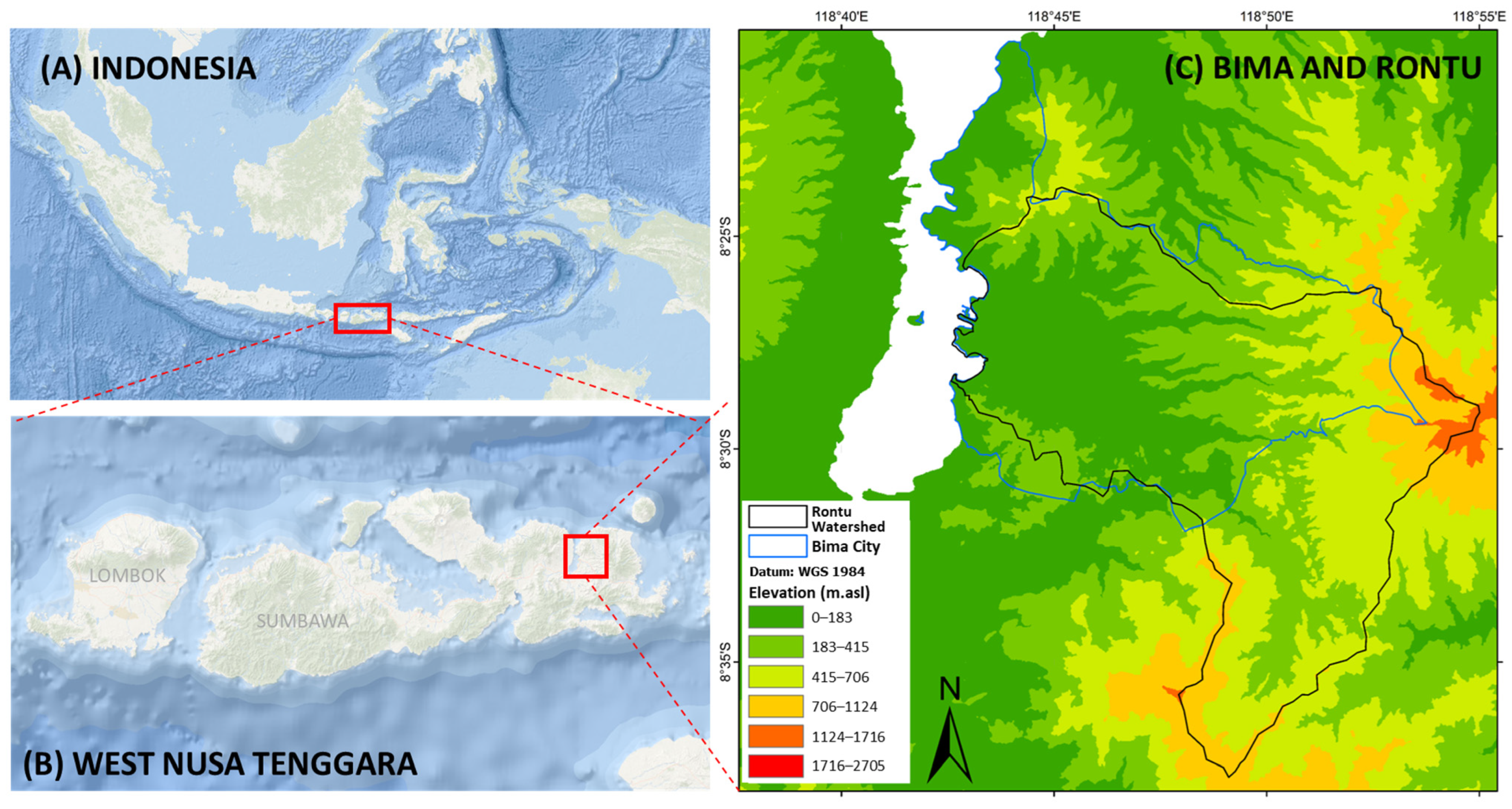
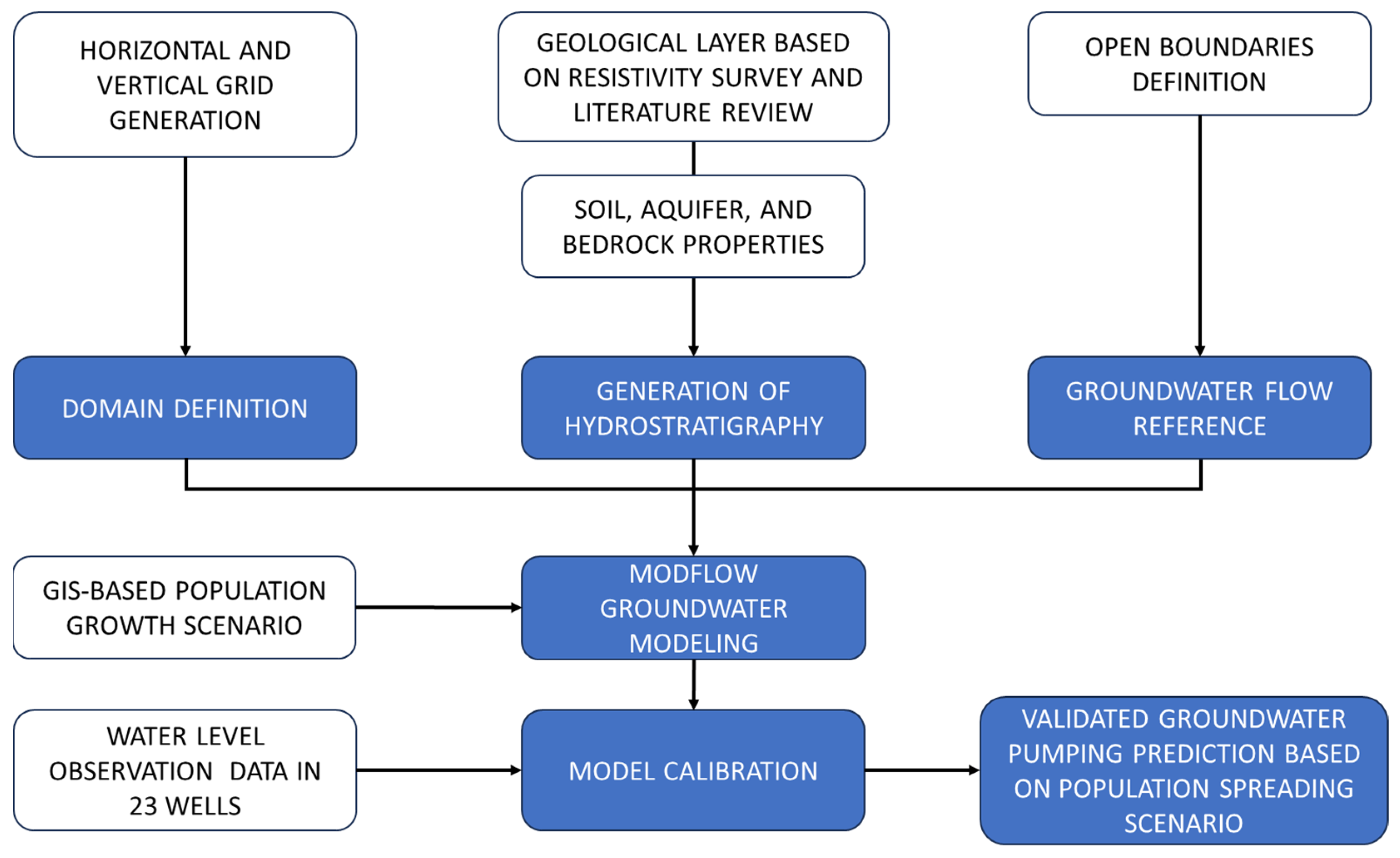
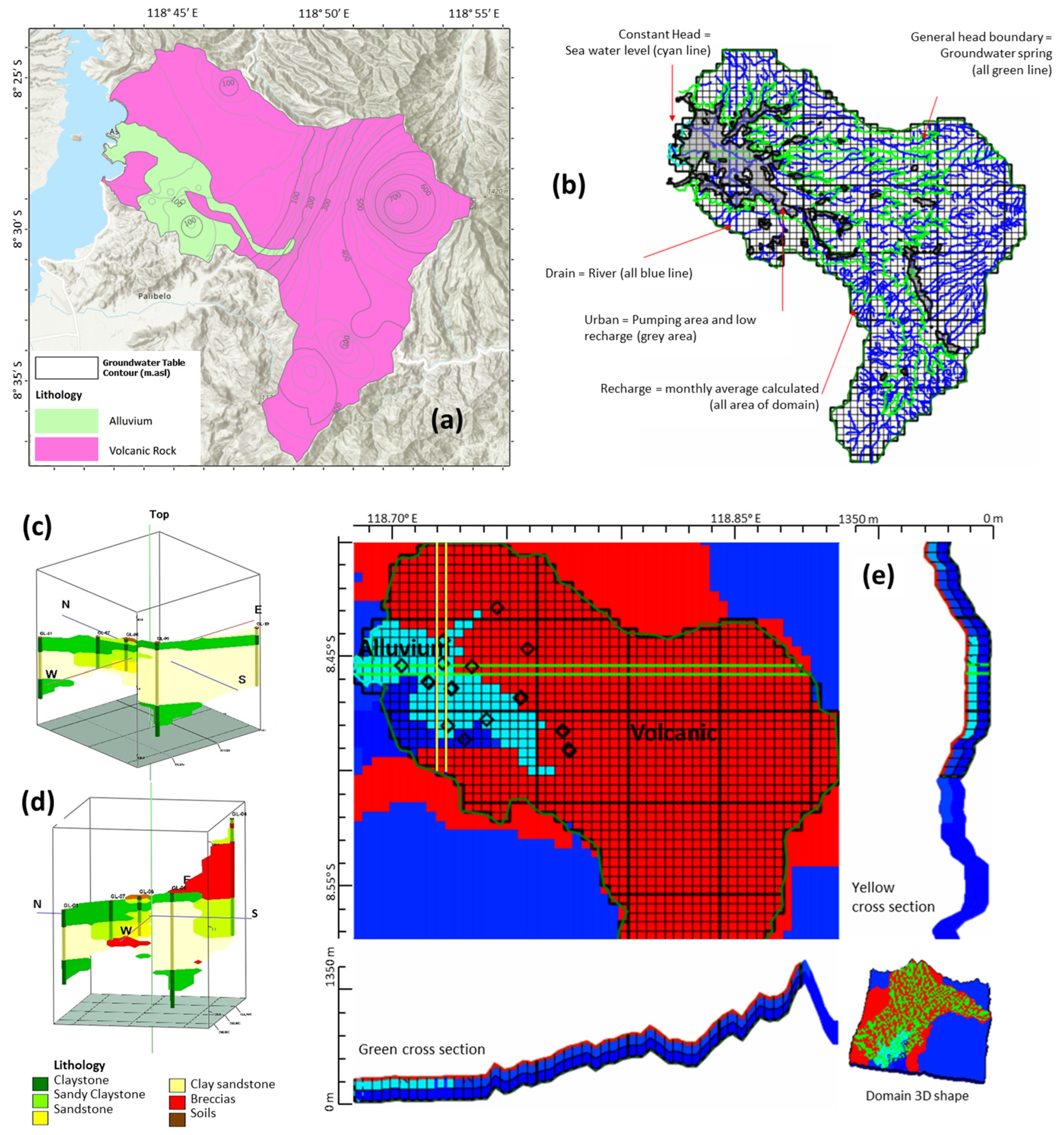


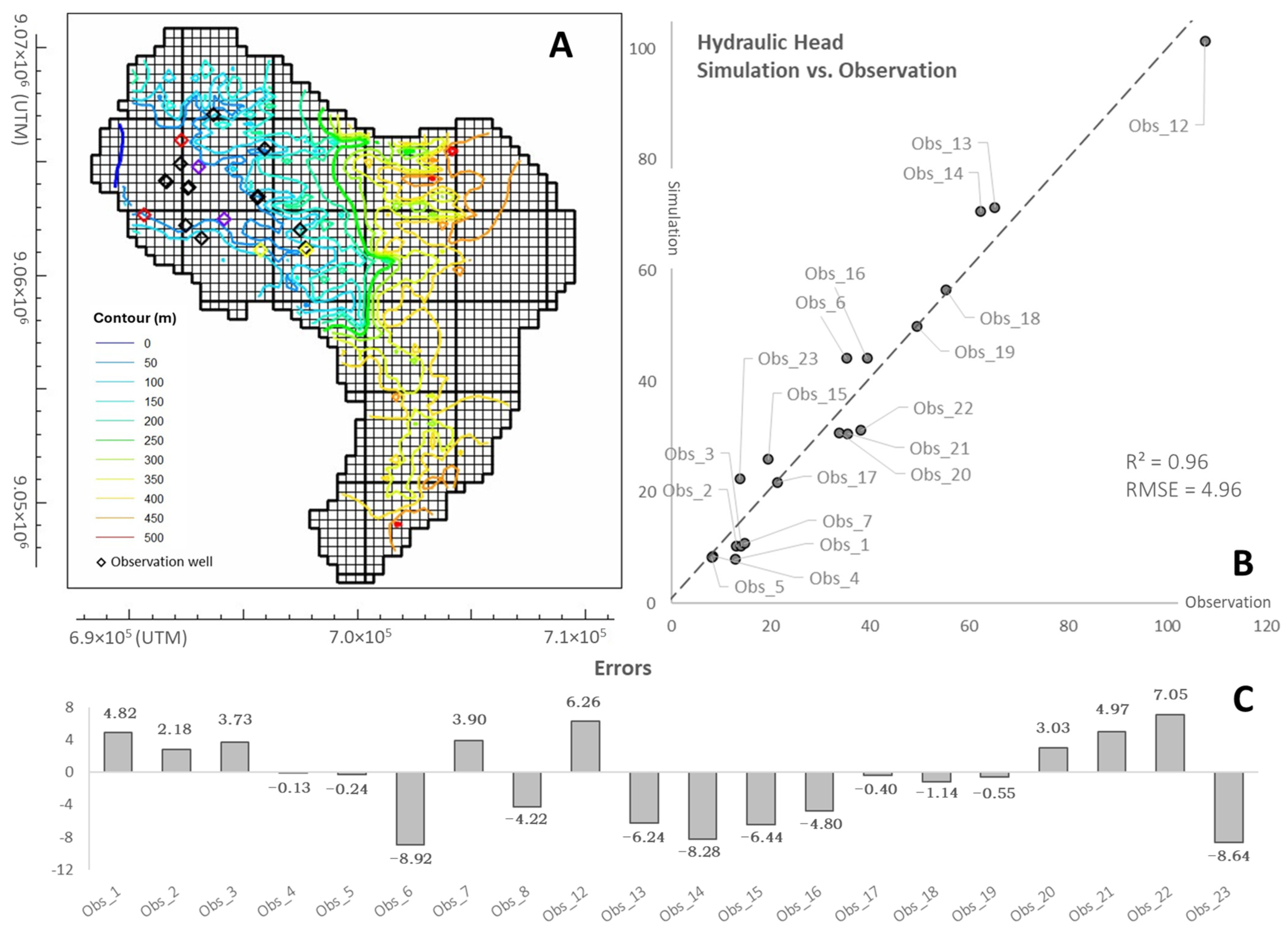
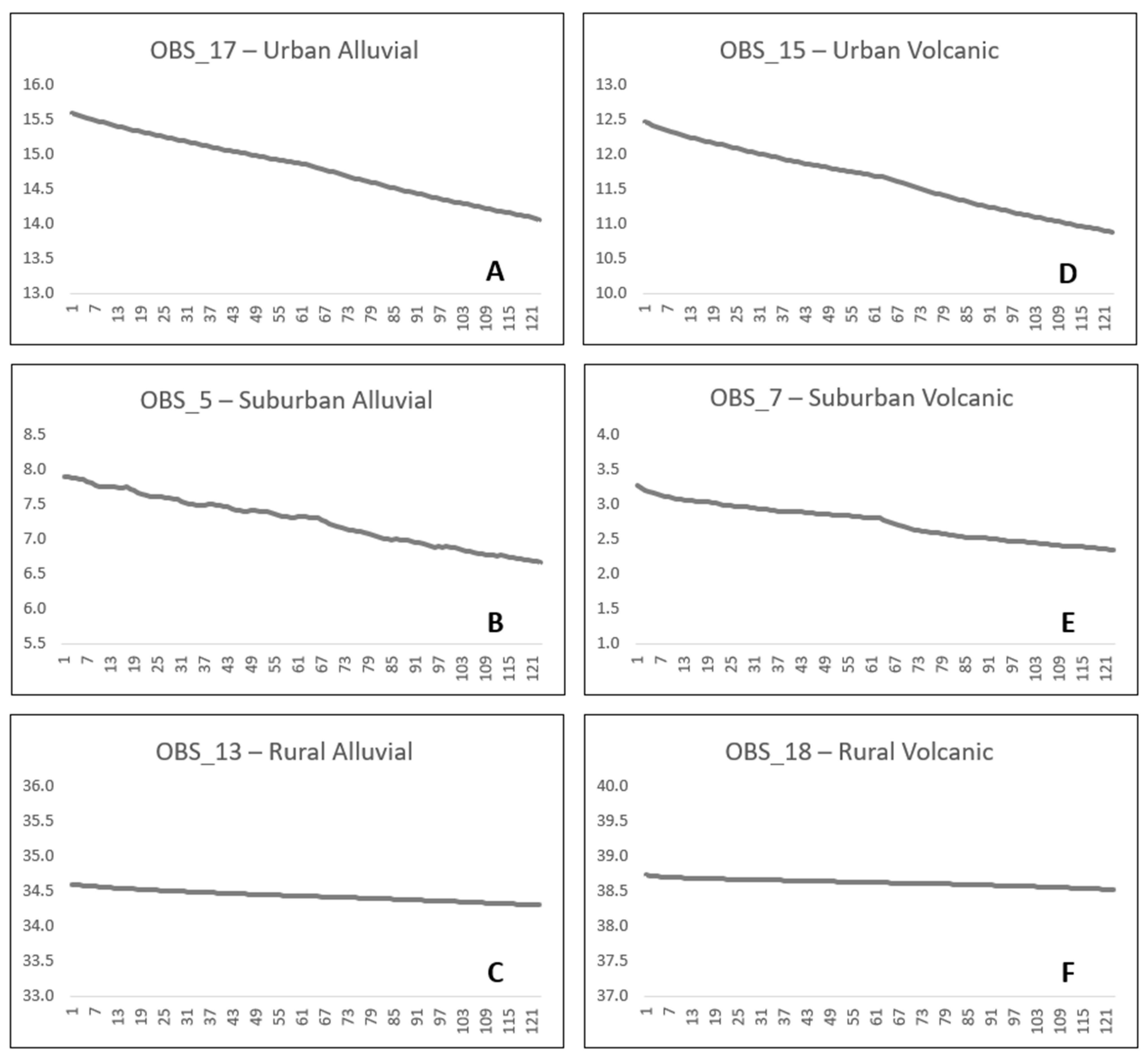
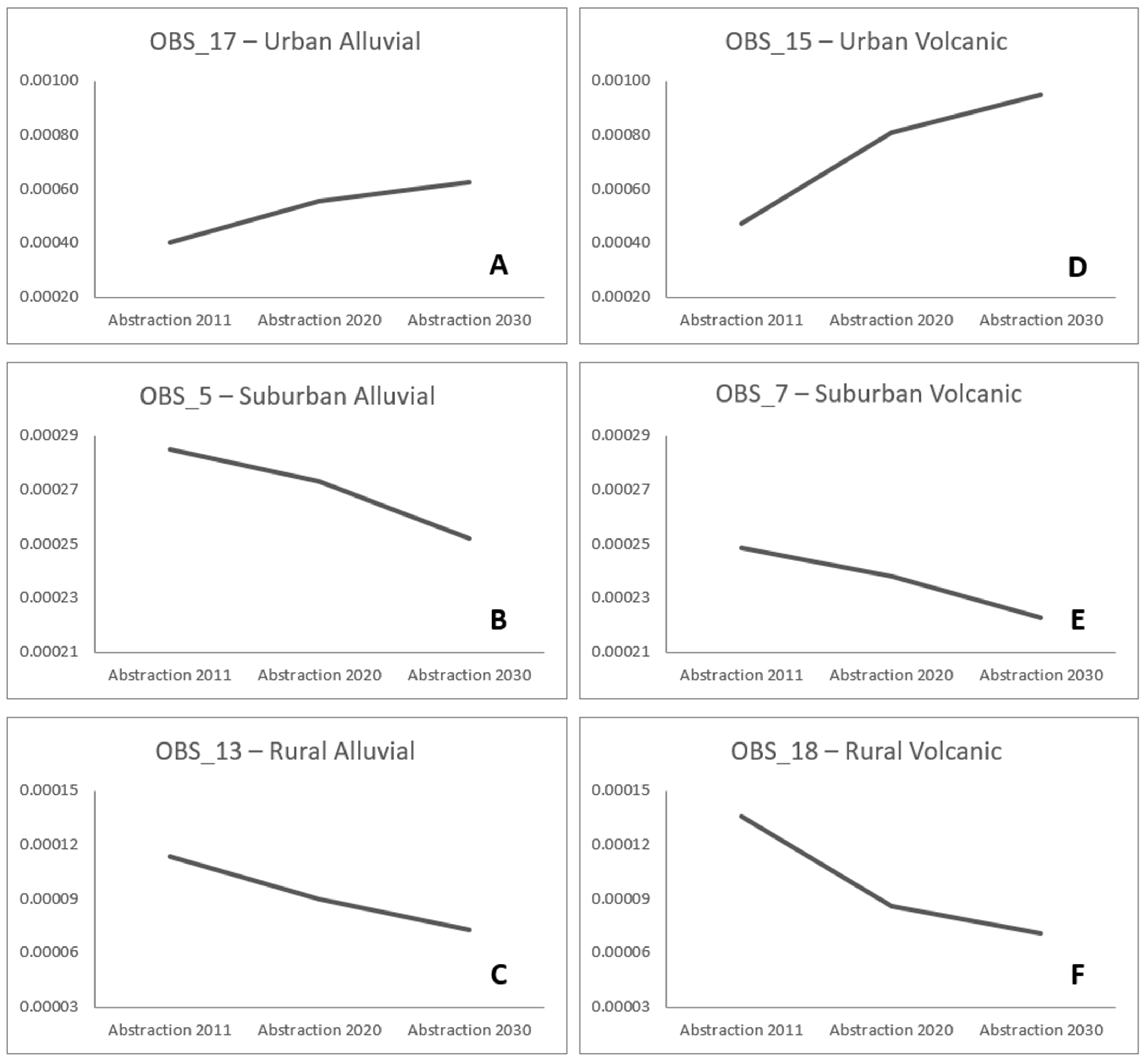
| Observation Well | Lithology | Population Density Type | 2011–2020 Drawdown (m) | 2030 Drawdown with 45% Pipeline Coverage (m) | 2030 Drawdown with 55% Pipeline Coverage (m) |
|---|---|---|---|---|---|
| Ob7 | Volcanic | Suburban | 0.92 | 0.25 | 0.10 |
| Ob5 | Alluvial | Suburban | 1.22 | 0.42 | 0.22 |
| Ob15 | Volcanic | Urban | 1.59 | 0.67 | 0.42 |
| Ob17 | Alluvial | Urban | 1.53 | 0.77 | 0.52 |
| Ob13 | Alluvial | Rural | 0.30 | 0.20 | 0.17 |
| Ob18 | Volcanic | Rural | 0.21 | 0.26 | 0.22 |
| Zone Budget (m3/s) | |
|---|---|
| In: | Out: |
| Storage = 1.2405 × 10−2 | Storage = 1.150 × 10−3 |
| Constant Head = 7.9965 × 10−2 | Constant Head = 0.1772 |
| Wells = 0.0000 | Wells = 6.6081 × 10−2 |
| Drains = 0.0000 | Drains = 2.9308 × 10−2 |
| Head Dep Bounds = 0.1628 | Head Dep Bounds = 2.0613 × 10−2 |
| Recharge = 1.2810 × 10−2 | Recharge = 0.0000 |
| Total In = 0.2680 | Total Out = 0.2680 |
Disclaimer/Publisher’s Note: The statements, opinions and data contained in all publications are solely those of the individual author(s) and contributor(s) and not of MDPI and/or the editor(s). MDPI and/or the editor(s) disclaim responsibility for any injury to people or property resulting from any ideas, methods, instructions or products referred to in the content. |
© 2023 by the authors. Licensee MDPI, Basel, Switzerland. This article is an open access article distributed under the terms and conditions of the Creative Commons Attribution (CC BY) license (https://creativecommons.org/licenses/by/4.0/).
Share and Cite
Husna, A.; Akmalia, R.; Rohmat, F.I.W.; Rohmat, F.I.W.; Rohmat, D.; Wijayasari, W.; Alvando, P.V.; Wijaya, A. Groundwater Sustainability Assessment against the Population Growth Modelling in Bima City, Indonesia. Water 2023, 15, 4262. https://doi.org/10.3390/w15244262
Husna A, Akmalia R, Rohmat FIW, Rohmat FIW, Rohmat D, Wijayasari W, Alvando PV, Wijaya A. Groundwater Sustainability Assessment against the Population Growth Modelling in Bima City, Indonesia. Water. 2023; 15(24):4262. https://doi.org/10.3390/w15244262
Chicago/Turabian StyleHusna, Abdullah, Rizka Akmalia, Faizal Immaddudin Wira Rohmat, Fauzan Ikhlas Wira Rohmat, Dede Rohmat, Winda Wijayasari, Pascalia Vinca Alvando, and Arif Wijaya. 2023. "Groundwater Sustainability Assessment against the Population Growth Modelling in Bima City, Indonesia" Water 15, no. 24: 4262. https://doi.org/10.3390/w15244262
APA StyleHusna, A., Akmalia, R., Rohmat, F. I. W., Rohmat, F. I. W., Rohmat, D., Wijayasari, W., Alvando, P. V., & Wijaya, A. (2023). Groundwater Sustainability Assessment against the Population Growth Modelling in Bima City, Indonesia. Water, 15(24), 4262. https://doi.org/10.3390/w15244262






